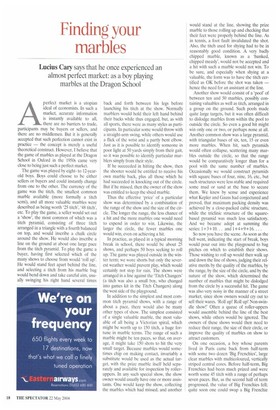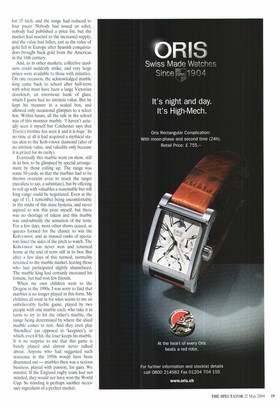Finding your marbles
Lucius Cary says that he once experienced an almost perfect market: as a boy playing marbles at the Dragon School Aperfect market is a utopian ideal of economists. In such a market, accurate information is instantly available to all, there are no barriers to trade, participants may be buyers or sellers, and there are no middlemen. But it is generally accepted that such perfection cannot exist in practice — the concept is merely a useful theoretical construct. However, I believe that the game of marbles as played at the Dragon School in Oxford in the 1950s came very close to being just such a perfect market.
The game was played by eightto 12-yearold boys. Boys could choose to be either sellers or buyers and could instantly change from one to the other. The currency of the game was the titch, the smallest common marble available (more formally a titch semi), and all more valuable marbles were described as being worth '25 titch', '48 titch', etc. To play the game, a seller would set out a 'show', the most common of which was a titch pyramid, consisting of three titch arranged in a triangle with a fourth balanced on top, and would inscribe a chalk circle around the show. He would also inscribe a line on the ground at about one large pace from the titch pyramid. To play the game a buyer, having first selected which of the many shows to choose from would 'roll up'. He would stand feet apart behind the line, and selecting a titch from his marble bag would bend down and take careful aim, usually swinging his right hand several times back and forth between his legs before launching his titch at the show. Normally marblers would hold their left hand behind their backs while thus engaged, but, as with all sports, there were as many styles as participants. In particular some would throw with a straight-arm swing, while others would use a flick of the wrist and a partly bent elbow. Just as it is possible to identify someone in poor light at 50 yards simply from their gait, so it was possible to identify particular marbiers simply from their style.
If he succeeded in hitting the show, then the shooter would be entitled to receive his own marble back, plus all those which he had succeeded in knocking out of the circle. But if he missed, then the owner of the show was entitled to keep the shied marble.
Thus the effective 'price' of a particular show was determined by a combination of the range of the show and the size of the circle. The longer the range, the less chance of a hit and the more marbles one would need to expend in order to win. Likewise, the larger the circle, the fewer marbles one would win, even on achieving a hit.
In practice, as played in a typical morning break in school, there would be about 25 shows, and perhaps 50 boys seeking to roll up. The game was played outside in the winter term; we wore shorts but only the severest weather would prevent play, which would certainly not stop for rain. The shows were arranged in a line against the `Titch Changers' (a titch was also a small boy, who changed into games kit in the Titch Changers) along the west side of the playground.
In addition to the simplest and most common titch pyramid shows, with a range of about a pace, there would also be many other types of show. The simplest consisted of a single valuable marble, the most valuable of all being a Victorian spiral, which might be worth up to 150 titch, a huge fortune in marble terms. The range of such a marble might be ten paces, so that, on average, it might take 150 shots to hit the very small target. Because marbles would sometimes chip on making contact, invariably a substitute would be used as the actual target, with the prize marble itself held separately and available for inspection by rolleruppers. In any such special show, the show owner would usually have one or more assistants. One would keep the show, collecting the marbles which had missed, and another
would stand at the line, showing the prize marble to those rolling up and checking that their feet were properly behind the line. As in tennis, a foot fault invalidated the shot. Also, the titch used for shying had to be in reasonably good condition. A very badly chipped marble, known as a 'bunked, chipped measly', would not be accepted and a hit with such a marble would not win. To be sure, and especially when shying at a valuable, the form was to have the titch certified as OK before the shot was taken — hence the need for an assistant at the line.
Another show would consist of a 'pool' of between ten and 50 marbles, possibly containing valuables as well as titch, arranged in a group on the ground. Such pools made quite large targets, but it was often difficult to dislodge marbles from within the pool to outside the circle. So even a good hit might win only one or two, or perhaps none at all. Another common show was a large pyramid, with triangular bases of six, ten, 15 or even more marbles. When hit, such pyramids would often collapse, scattering many marbles outside the circle, so that the range would be comparatively longer than for a pool with the same number of marbles. Occasionally we would construct pyramids with square bases of four, nine, 16, etc., but such structures were less stable and required some mud or sand at the base to secure them. We knew by sense and experience what Kepler and Gauss had conjectured and proved, that maximum packing density was achieved by a close-packed cubic structure, while the triclinic structure of the squarebased pyramid was much less satisfactory. And we became adept at summing the series: 1+3+10... and 1+4+9+16.. . .
So now you have the scene. As soon as the bell went, indicating the start of break, boys would pour out into the playground to bag pitches on which to establish their shows. Those wishing to roll up would then walk up and down the line of shows, judging their relative merits by the quality of the marbles, by the range, by the size of the circle, and by the nature of the show, which determined the number of marbles that might be dislodged from the circle by a successful hit. The game was also very noisy in the manner of a street market, since show owners would cry out to sell their wares. 'Roll up! Roll up! Non-swindle show!' Often a queue of roller-uppers would assemble behind the line of the best shows, while others would be ignored. The owners of these shows would then need to reduce their range, the size of their circle, or improve the quality of marbles on show to attract customers.
On one occasion, a boy whose parents lived in Paris came back from half-term with some two dozen 'Big Frenchies', large clear marbles with multicoloured, vertically striped central cores. Before half-term, Big Frenchies had been much prized and were worth some 45 titch with a range of perhaps seven paces. But, as the second half of term progressed, the value of Big Frenchies fell; quite soon one could swap a Big Frenchie for 15 titch, and the range had reduced to four paces. Nobody had issued an edict, nobody had published a price list, but the market had reacted to the increased supply, and the value had fallen, just as the value of gold fell in Europe after Spanish conquistadors brought back gold from the Americas in the 16th century.
And, as in other markets, collective madness could suddenly strike, and very large prizes were available to those with initiative. On one occasion, the acknowledged marble king came back to school after half-term with what must have been a large Victorian doorknob, an enormous hunk of glass, which I guess had no intrinsic value. But he kept his treasure in a sealed box, and allowed only occasional glimpses to a select few. Within hours, all the talk in the school was of this monster marble. I haven't actu ally seen it myself but Colchester says that Travis's brother has seen it and it is huge.' In no time at all it had acquired a mythical sta tus akin to the Koh-i-noor diamond (also of no intrinsic value, and valuable only because it is prized for its rarity).
Eventually this marble went on show, still in its box, to be glimpsed by special arrange ment by those rolling up. The range was some 50 yards, so that the marbles had to be thrown overarm even to reach the target (needless to say, a substitute), but by offering to roll up with valuables a reasonable but still long range could be negotiated. Even at the age of 11, I remember being uncomfortable in the midst of this mass hysteria, and never aspired to win this prize myself, but there was no shortage of takers and this marble was undoubtedly the sensation of the term. For a few days, most other shows ceased, as queues formed for the chance to win the Koh-i-noor, and as massed ranks of spectators lined the sides of the pitch to watch. The Koh-i-noor was never won and returned home at the end of term still in its box. But after a few days of this turmoil, normality returned to the marble market, leaving those who had participated slightly shamefaced. The marble king had certainly increased his fortune, but had won few friends.
When my own children went to the Dragon in the 1990s, I was sorry to find that marbles is no longer played in this form. My children all went in for what seems to me an unbelievably feeble game, played by two people with one marble each, who take it in turns to try to hit the other's marble, the range being determined by where the shied marble comes to rest. And they even play 'friendlies' (as opposed to leepsies), in which, even if hit, the loser keeps his marble.
It is no surprise to me that this game is barely played and almost never talked about. Anyone who had suggested such nonsense in the 1950s would have been drummed out — marbles then was a serious business, played with passion, for gain. We minded. If the England rugby team had not minded, they would not have won the World Cup. So minding is perhaps another necessary ingredient of a perfect market.



















































































 Previous page
Previous page